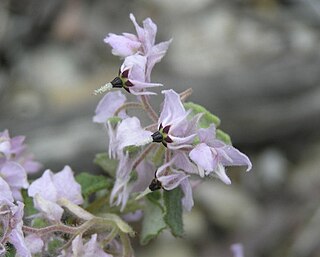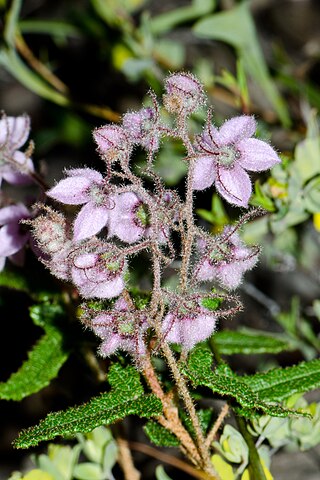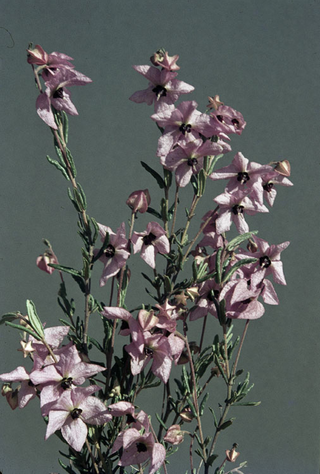
Lasiopetalum floribundum, commonly known as free flowering lasiopetalum, is a species of flowering plant in the family Malvaceae and is endemic to the south-west of Western Australia. It is an erect or spreading shrub with hairy young stems, egg-shaped leaves and pale pink, mauve or white flowers.

Hibbertia polystachya is a species of flowering plant in the family Dilleniaceae and is endemic to the south-west of Western Australia. It is an erect to sprawling or straggly shrub with narrow elliptic to linear leaves and yellow flowers arranged in groups of up to five with about ten stamens and a similar number of staminodes, arranged on one side of two hairy carpels.
Lasiopetalum adenotrichum is a species of flowering plant in the family Malvaceae and is endemic to the Fitzgerald River National Park in the south of Western Australia. It is an erect shrub with hairy foliage, narrow egg-shaped to lance-shaped leaves and groups of white to cream-coloured and dark reddish-purple flowers.
Lasiopetalum angustifolium, commonly known as narrow leaved lasiopetalum, is a species of flowering plant in the family Malvaceae and is endemic to coastal areas of south-western Western Australia. It is a low spreading or dense, compact shrub with narrowly egg-shaped to narrowly elliptic leaves and compact groups of pink to purplish flowers.

Lasiopetalum bracteatum, commonly known as Helena velvet bush, is a species of flowering plant in the family Malvaceae and is endemic to the south-west Western Australia. It is an erect, spreading shrub with egg-shaped leaves and loose groups pinkish flowers.
Lasiopetalum compactum, is a species of flowering plant in the family Malvaceae and is endemic to the south-west of Western Australia. It is an erect shrub with leathery, narrowly oblong leaves and cymes of white to pinkish flowers.

Lasiopetalum drummondii is a species of flowering plant in the family Malvaceae and is endemic to the south-west of Western Australia. It is an erect, slender shrub with many densely hairy stems, egg-shaped or oblong leaves and white, pink and red flowers.
Lasiopetalum ferraricollinum is a species of flowering plant in the family Malvaceae and is endemic to the south-west of Western Australia. It is an upright shrub with densely hairy stems, narrow egg-shaped to oblong leaves and white to cream-coloured and dark red flowers.
Lasiopetalum laxiflorum is a species of flowering plant in the family Malvaceae and is endemic to the south-west of Western Australia. It is a sticky, straggling subshrub or shrub with many densely hairy stems, egg-shaped leaves, and bright pink and dark red flowers.
Lasiopetalum membranaceum is a species of flowering plant in the family Malvaceae and is endemic to near-coastal areas of south-western Western Australia. It is an erect, spreading shrub or subshrub with hairy young stems, egg-shaped leaves and mauve-pink and dark red flowers.
Lasiopetalum monticola is a species of flowering plant in the family Malvaceae and is endemic to the south-west of Western Australia. It is an erect, slender or straggling shrub with densely hairy branchlets, leaves and flowers, egg-shaped leaves and pink, cream-coloured or white flowers.

Lasiopetalum ogilvieanum is a species of flowering plant in the family Malvaceae and is endemic to the south-west of Western Australia. It is an open, spindly or rounded shrub with rusty-hairy young stems, narrowly egg-shaped to narrowly elliptic leaves and white or pink and dark red flowers.

Lasiopetalum oldfieldii is a species of flowering plant in the family Malvaceae and is endemic to the south-west of Western Australia. It is a low, spreading shrub with rusty-hairy young stems, egg-shaped to narrowly egg-shaped leaves and pink and dark red flowers.

Lasiopetalum quinquenervium is a species of flowering plant in the family Malvaceae and is endemic to the south of Western Australia. It is an erect, spreading shrub with hairy stems and leaves, egg-shaped leaves and pink or white flowers.

Lasiopetalum rosmarinifolium is a species of flowering plant in the family Malvaceae and is endemic to the south-west of Western Australia. It is an erect or spreading shrub with hairy stems and leaves, linear leaves and white flowers.

Lasiopetalum rotundifolium is a species of flowering plant in the family Malvaceae and is endemic to the south-west of Western Australia. It is an erect to spreading shrub with hairy young stems, round leaves with a heart-shaped base, and pink and dark red flowers.

Lasiopetalum trichanthera is a species of flowering plant in the family Malvaceae and is endemic to a restricted area in the south-west of Western Australia. It is an erect to straggling, sticky shrub with many hairy stems, egg-shaped leaves and bright pink and dark red flowers.

Lasiopetalum venustum is a species of flowering plant in the family Malvaceae and is endemic to a restricted area in the south-west of Western Australia. It is an erect shrub with hairy stems, egg-shaped, three-lobed leaves and pink and dark red flowers.

Guichenotia sarotes is a species of flowering plant in the family Malvaceae and is endemic to the southwest of Western Australia. It is a spindly, low-growing shrub with densely hairy new growth, hairy, greyish, linear leaves and pink to purple flowers arranged in loose groups of two to six.

Guichenotia micrantha, commonly known as small flowered guichenotia, is a species of flowering plant in the family Malvaceae and is endemic to the south-west of Western Australia. It is a low, compact shrub with linear to narrowly egg-shaped leaves and pink flowers in groups of three to six.













